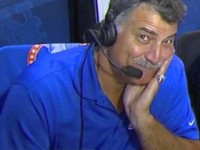Michael Cuddyer
Despite slugging .533 over the last two months of the season, and homering in seven consecutive postseason games, including home runs off Clayton Kershaw, Zack Greinke, Jon Lester, Jake Arrieta, and Kyle Hendricks, the Mets only made the perfunctory qualifying offer to NLCS MVP Daniel Murphy. At the time, the qualifying offer was made no player had ever accepted the qualifying offer.
The Mets thought process was grounded in several factors. First, they believed they could get Ben Zobrist, who they viewed as a superior player. Second, the Mets could recoup the first round draft pick they lost by signing Michael Cuddyer in the previous offseason. Third, and most importantly, the Mets didn’t foresee Murphy carrying that level of production for a full season in 2016 and beyond.
That last point became all the more apparent when, after the Mets lost out in Zobrist, they traded Jon Niese (who was later re-acquired in exchange for Antonio Bastardo) for Neil Walker. The Mets made this move despite never inquiring what it would take to re-sign Murphy.
The logic of the Walker trade was the Mets were getting an All Star second baseman in his walk year. Should he perform, the Mets could either re-sign him, or they could make the qualifying offer and recoup another draft pick. Should he falter or leave in free agency, the Mets could turn the position over to second baseman of the future Dilson Herrera.
Walker would have a career year for the Mets both at the plate and in the field. Overall, he would hit .282/.347/.476 with 23 homers and 55 RBI. Those numbers are even better when you consider that the switch hitting Walker was no longer a liability from the right side of the plate. Rather, he was a dominant force.
Unfortunately, Walker would go through part of the summer unable to feel his feet due to a herniated disc. Despite his being in the best stretch of the season and the Mets fighting for the Wild Card, he would have to undergo season ending lumbar microdiscetomy surgery.
While the Mets remain hopeful Walker will recover fully, and that the two sides can agree to a deal, nothing is guaranteed. The Mets need Walker to recover with no issues because Herrera was moved in the trade to acquire Jay Bruce.
Now, many will say this has all been a debacle as Murphy had an MVP caliber season for the rival Washington Nationals. This year, Murphy hit .347/.390/.595 with 47 doubles, five triples, 25 homers, and 104 RBI. He led the league in doubles, slugging, and OPS. Worse yet, he killed the Mets getting a hit in all 19 games against them while hitting .413/.444/.773 with six doubles, seven homers, and 25 RBI.
In response to that, many will say judging the Mets decision on Murphy is unfair as: (1) no one saw this coming; and (2) you are using hindsight to criticize the Mets.
That argument is unfounded. First and foremost, the General Manager is supposed to have foresight. He is paid to make sure what happened with Murphy never happens. Second, and most importantly, the argument is patently false.
As Mets hitting coach Kevin Long told MLB Network Radio, “Daniel Murphy became a monster overnight, once he got it, you knew he wasn’t going to lose it.”
Murphy certainly hasn’t lost it. In fact, he was even better leading the Nationals to an NL East title over the Mets. Tonight, he looks to recreate his incredible Game Five performance against the Dodgers so he can once again torture the Cubs in the NLCS.
Meanwhile, the Mets are looking at their second base options, which assuredly are no better than Murphy, in what is an extremely weak free agent class, after being shutout in the Wild Card Game. It didn’t have to be this way as the Mets coaching staff saw Murphy putting together a season like this.
By the way, Anthony Kay, the pick the Mets received for Murphy becoming a National, had to have Tommy John surgery before he ever threw a pitch as a professional.
Last year, the Mets were coming off an absolutely brutal loss to the San Diego Padres on the eve of the trade deadline. As the team blew a 7-1 lead, it seemed like all hope was lost.
However, the Mets front office didn’t share the same sense of diapair. They were active on the phones trying to improve a team that was three games behind the Nationals. They were a team who had an extremely weak August schedule. They were a team in the mend with Travis d’Arnaud, Michael Cuddyer, and David Wright expected to return from the disabled list.
It was a good team getting healthy facing a favorable schedule ready for a three game set at home against the first place Nationals. It was behind this backdrop that the Yoenis Cespedes trade happened.
Seeing Cespedes hobbled out there is a stark reminder that this year is not last year. This is a Mets team that isn’t getting healthy. In fact, they’re falling like flies. Here is a list of the players currently on the disabled list:
- David Wright
- Lucas Duda
- Matt Harvey
- Juan Lagares
- Jose Reyes
- Jim Henderson
This does not include Noah Syndergaard or Steven Matz who both have bone spurs in their pitching elbows that will need to be surgically removed in the offseason.
This list also does not even include Asdrubal Cabrera who left yesterday’s game with what is initially being described as a strained patellar tendon. He seems as if he’s bound for the disabled list. With Cabrera going down, it will create another hole in not just the lineup, but with the defense.
With Cespedes’ injury and Lagares’ surgery, the Mets are left scrambling to find a center fielder. They have tried Curtis Granderson out there, and after one game, the Mets saw enough. Against righties, the Mets have tried Michael Conforto in center, and he has held his own. Just recently, the Mets signed Justin Ruggiano, who was playing in AAA before being released by the Rangers.
With Cabrera injured and seemingly bound for the disabled list, it leaves the Mets scrambling to find adequate defenders at the two most important defensive positions. It will also mean Neil Walker, who has hit .234/.316/.343 since May 1st, will be the only starting infielder remaining from the Opening Day Lineup.
By no means is Walker the only one struggling:
- 2015 – .259/.364/.457 with 33 doubles, two triples, 26 homers, and 70 RBI
- 2016 – .234/.326/.431 with 16 doubles, four triples, 16 homers, and 29 RBI
Michael Conforto
- 2015 – .270/.335/.506 with 14 doubles, nine homers, and 26 RBI
- 2016 – .225/.303/.419 with 14 doubles, or triple, 10 homers, homers, and 30 RBI
Travis d’Arnaud
- 2015 – .268/.340/.485 with 14 doubles, one triple, 12 homers, and 42 RBI
- 2016 – .249/.290/.321 with five doubles, two homers, and 10 RBI
All across the diamond, the Mets are dealing with injuries, under performance, or both. According to Baseball Reference, the Mets have the lowest team WAR at shortstop, third base, and right field among National League teams in the playoff hunt.
Further exacerbating the Mets struggles is their August schedule. There are the four emotionally charged Subway Series games along with series against the Tigers, Giants, Cardinals, and Marlins. There is s short West Coast trip. The combined record of their opponents is 416-369, which is good for a .530 winning percentage. With this schedule and the state of the Mets roster, things can fall apart quickly.
In reality, neither Jonathan Lucroy nor Jay Bruce help these problems. They do not solve the defensive gap at short or center. They cannot heal the players on the disabled list. They cannot make the schedule any easier. No, the only thing they can do is to join the Mets and play well.
However, if the Mets don’t get healthy or start playing better, there’s no point in adding Lucroy or Bruce. They don’t solve the Mets real problems, and they likely don’t put the Mets over the top.
With that in mind, there’s no sense on buying at the deadline. You’re just purging prospects to help acquire players who will most likely not be difference makers. There’s also no sense to selling because this is a talented team that needs to find that next gear.
With that in mind, as frustrating as it might be, the Mets best option might be to stand pat.
With the Nationals starting a left-handed pitcher in Gio Gonzalez, Terry Collins was going to start Juan Lagares no matter what. On the one hand, Collins will tell you he wants Lagares’ bat in the lineup against lefties. In reality, Collins just doesn’t trust young left-handed hitters against left-handed pitching.
With that in mind, when Collins filled out the lineup card yesterday, he had Lagares in center, Curtis Granderson in right, and Alejandro De Aza in left. Collins started De Aza despite the fact that De Aza entered the game hitting .181/.252/.276. He started De Aza despite the fact that De Aza is a career .235/.299/.350 hitter against lefties. Looking at these numbers and just how poorly De Aza has played this entire year, Collins decided to start De Aza. In a shock to no one, De Aza was 0-3 on the day in a game that the Mets lost 3-2. There is really no justification for this decision other than the unsupported notion that Nimmo can not hit lefties.
Before his call-up, Nimmo was hitting .338/.338/.500 in 74 at bats against lefties. Given these stats, it’s fair to assume that Nimmo would be a better bet to hit a lefty than De Aza would. However, Collins isn’t willing to give him the chance. He would rather hamper a player’s development and stick with a veteran who has already proved he cannot do the job. It’s the same thing Collins did last year with Michael Cuddyer and Michael Conforto.
Last year, Cuddyer was just a shell of himself. He needed core muscle surgery. He had a knee injury that plagued him all year. Through all of it, Cuddyer hit just .259/.309/.391. It was a far cry from the career .277/.344/.461 career hitter he was. Despite Cuddyer showing he no longer could play up to the level he once could, Collins decided it was better to play him against lefties than it was to play the rookie Conforto who was hitting well in the majors. Collins made this decision despite the fact that Conforto was hitting .333/.414/.490 against lefties in AA. Still, for whatever reason Collins could conjure, he determined that Conforto was not able to hit lefties at the major league level. The idea got so stuck in his head that Collins followed the same plan coming into this season.
Then suddenly it happened. Conforto was no longer able to hit left-handed pitching he had not seen in quite a while. In 2016, Conforto hit .091/.128/.091 in his 44 at bats against lefties this season. This would then become part of a greater overall issue where Conforto stopped hitting all together. The seminal moment was the time Collins actually let Conforto hit against a lefty. In true Collins’ fashion, the lefty he chose was Madison Bumgarner. Conforto would go 0-5 on the day. He then went into a prolonged slump that saw him hit .148/.217/.303 over his next 44 games. In that span, Conforto went from hitting .365/.442/.676 on the season to hitting .222/.296/.431. The Mets were all but forced to send him down to the minors and call-up the left-hand hitting Nimmo.
Sure enough, Collins is repeating the same mistakes with Nimmo as he did with Conforto. Last year, it was to get Cuddyer at bats. This year, it is to get De Aza at bats. It didn’t make sense then, and it makes less sense now.
Yesterday, the Mets drafted a player in the first round after forfeiting their 2015 pick to sign Michael Cuddyer. The Mets did get a second first round pick because Daniel Murphy signed with the Nationals. Accordingly, the Sandy Alderson regime has now drafted six players in the first round. Can you name all of them? Good luck!
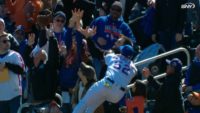
Last year, the Mets saw lengthy absences from David Wright and Travis d’Arnaud. Daniel Murphy and Michael Cuddyer were nicked up most of the year. Other Mets players got bumps and bruises along the way. The Mets depth got tested early and often in 2015, and it was ugly.
Dilson Herrera and Kevin Plawecki showed they weren’t ready to hit major league pitching. For his part, Plawecki had to stay in the lineup because Anthony Recker and Johnny Monell weren’t either. Eric Campbell and John Mayberry, Jr. showed why they weren’t everyday players, let alone middle of the order bats. There were other forgettable debuts from players like Darrell Ceciliani and Danny Muno. In 2015, the Mets bet against their farm system, and it nearly cost them the season.
In the offseason, the Mets made sure to build a deeper roster. They moved Wilmer Flores to a utility role. Alejandro De Aza is here as a fifth outfielder. Juan Lagares is a part time player who will start against lefties and come on as a late defensive replacement. Herrera is back in AAA where he belongs for now. Campbell and Plawecki are on the 25 man roster, but they are asked to do much less. Hypothetically, it’s a much deeper team.
Well, that hypothesis is now being put to the test.
Yoenis Cespedes has been dealing with a thigh issue due to his jumping in the stands and an awkward slide. As for now, he’s not DL bound. Yesterday, d’Arnaud left the game early with pain in his throwing shoulder. While he may not have been the best at throwing out would be base stealers, his throws were uncharacteristically poor. He will be examined today before a DL decision is made. Whether it will be one day, one week, one month, or more, the Mets will miss Cespedes and d’Arnaud.
No matter how much time if will be, this Mets team is better built to sustain these losses. Having a De Aza/Lagares platoon is a much better option than Ceciliani. Plawecki has another year of development under his belt. Hopefully, this translates to him having a better year at the plate.
The Mets better hope so. The Nationals look like a different team than they were a year ago. The Mets aren’t going to be able to coast for two – three months with subpar players. This is a new year. Fortunately, this is a new Mets team that’s built for just these types of situations.
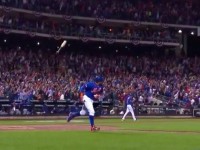
What I’ve found is most of the people that support the Yoenis Cespedes trade is he transformed the offense, and he was the reason the Mets won the NL East. Other people say while Cespedes was great with the Mets, there were other more important factors helping the Mets win the NL East. These arguments rest upon the Mets getting healthy and a weak August schedule.
I think the best way to look at this is just to present the facts. I’m presenting them unadulterated and without comment. Before presenting them, remember that Cespedes’ first game with the Mets was 8/1.
Pre-Cespedes Record: 53 – 51
Post-Cespedes Record: 37 – 21
In the same time frame, here is the Nationals record:
Pre-Cespedes Record: 54-47
Post-Cespedes Record: 29-32
Mets Opponents Combined Win Percentage and Mets Record by Month:
April Opponents .458 Mets 15-8
May Opponents .510 Mets 13-15
June Opponents .483 Mets 12-15
July Opponents .537 Mets 13-12
August Opponents .480 Mets 20-8
September/October Opponents .458 Mets 17-14
Here is the Mets and Nationals records and position in the standings at the end of every month:
April
Mets 15-8
Nats 10-13 (5.0 games back)
May
Nats 28-22
Mets 28-23 (0.5 games behind)
June
Nats 43-34
Mets 40-38 (3.5 games behind)
July
Nats 54-47
Mets 53-50 (2.0 games behind)
August
Mets 73-58
Nats 66-64 (6.5 games behind)
September/October
Mets 90-72
Nats 83-79 (7.0 games behind)
Overall, the Mets went from 2.0 games behind heading into August to 6.5 games up at the end of the month. As stated above the Mets record in August was 20-8 against opponents with a .480 winning percentage. The Nationals went 12-17 against opponents with a .490 winning percentage. Aside from the records, here is some additional information to consider:
Dates Key Players Came off the DL for good (by first game played after activation):
Travis d’Arnaud July 31st
Daniel Murphy June 30th
David Wright August 24th
Michael Cuddyer August 11th
Here are some other key dates from the 2015 season to consider:
July 24 – Michael Conforto called up from AA
July 24 – Mets trade for Juan Uribe and Kelly Johnson
July 27th – Mets trade for Tyler Clippard
July 30 – John Mayberry, Jr. released
July 31 – Mets trade for Cespedes
August 1 – Cespedes plays first game with the Mets
Again, I’m making no comment on any of this information. It’s being presented to review it and process it. Upon reviewing the information, does your judgment on how Cespedes impacted the Mets change or remain the same?
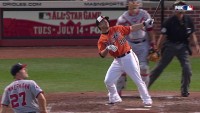
It seems like long ago the Mets decided they didn’t want the expensive top end talent for 2016. They are actively seeking a deeper 25 man roster over a more talented starting nine. To that end, the Mets have interest in Steve Pearce.
Pearce is a career .246/.325/.431 right handed hitter. He has a career OPS+ of 105. He had a great 2014 hitting .293/.373/.556 with 21 homers, 49 RBI, and an OPS+ of 157 in 102 games. Last year, he had a steep drop off. He hit .218/.289/.422 with 15 homers, 40 RBI, and a 91 OPS+ in 92 games. Overall, this tells us he’s a bench player. You really never know what you’re going to get year to year. He has the potential to be really good and really bad. The question is if he can help the Mets.
The 2014 version can. The 2015 version was no better than Eric Campbell. On average, he’s a useful player. He’s an adequate 1B/OF. To that end, he could replace Michael Cuddyer‘s expected production, even if he won’t replace his clubhouse presence. If the Mets do obtain Pearce, it should be as an occasional started against tough lefties instead of being your prototypical National League bench player.
For his career, Pearce hits .238/.314/.400 against righties and .262/.343/.481 against lefties. With platoon splits like these, he is a good candidate to take at bats against tough lefties in place of Curtis Granderson or Michael Conforto. Just don’t ask him to pinch hit. As a pinch hitter, Pearce hits .170/.255/.284. Yes, 98 plate appearances is a small sample size, but those numbers are just bad no matter how you slice and dice it. Signing him fills out the roster almost completely. It also makes Wilmer Flores that top right handed pinch hitter. That’ll be hard with the Mets having him play everywhere next season.
Overall, Pearce could help the Mets. He may not be an exciting move, but then again depth moves rarely are. To that end, signing him would be the perfect end to the offseason.
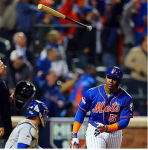
After the Mets signed Alejandro De Aza, the Mets fans realized the team was breaking its promises, and they became angry. They came to the realization that the team was not going to increase payroll, at least not significantly, after attendance increased.
Right now, I could remind everyone of the Mets great starting pitching in an attempt to calm everyone down. However, I don’t think it’s that time. Honestly, the fans need to be angry with the team lying to them. The team needs to answer questions why ticket prices increased while the payroll was decreased. The only way I truly know how to make that happen is to tell everyone the Mets punted on Yoenis Cespedes.
Cespedes is projected to receive a contract around $21.5 million per year. Jason Heyward signed a deal worth approximately $23 million a year. If you assume Heyward was the top free agent, the $21.5 million is a good approximation.
We know Michael Cuddyer. We don’t know if he received a buyout. He was due to make $12.5 million. De Aza just signed for $5.75 million, and he can earn up to $1.25 million in incentives. That’s potentially $7 million. Collectively, that’s potentially $19.5 million.
That’s right. The De Aza signing really did cost the Mets Cespedes. The money saved in the series of transactions starting with the Neil Walker trade and Cuddyer retirement wasn’t used to get the power bat the Mets need.
Yes, I don’t think the Mets should re-sign him. However, I do think they should’ve used the money to improve the roster. They haven’t done that. For me, I thought the Mets should’ve created a lockdown bullpen while bringing back Daniel Murphy. For others, it’s Cespedes.
For the Mets, it was pocketing the money while bringing on De Aza.
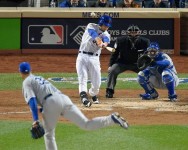
There are many out there calling the Mets offseason a success so far. Personally, I don’t see it. Yes, I know the offseason isn’t over, but we’re also pretty sure the Mets aren’t replacing Yoenis Cespedes‘ bat.
Overall, the Mets as constituted now are not better than the team that lost the World Series. Here was the lineup for the team that just lost the World Series, with their respective WAR from the 2015 season:
- Curtis Granderson 5.1
- David Wright 0.5
- Daniel Murphy 1.4
- Yoenis Cespedes 6.3
- Lucas Duda 3.0
- Travis d’Arnaud 1.7
- Michael Conforto 2.1
- Wilmer Flores 0.8
Combined 20.9
If the Mets make no other additions this offseason, which still remains a possibility, here’s the Mets 2016 starting lineup with the player’s WAR from last year.
- Curtis Granderson 5.1
- Neil Walker 2.4
- David Wright 0.5
- Lucas Duda 3.0
- Asdrubal Cabrera 1.7
- Michael Conforto 2.1
- Travis d’Arnaud 1.7
- Juan Lagares 0.6
Combined 17.1
On paper, barring any further additions the 2016 starting lineup is worse than the 2015 World Series team. This is despite how more “athletic” the Mets are in the middle infield. In response, the argument is the Mets are now deeper. Are they? Let’s compare the 2015 and 2016 benches.
Before comparing, it should be noted I’m going to use a traditional 13 position players and 12 pitchers split. That means I will have to eliminate once bench player from the 2015 Mets. I’m choosing to remove Kirk Nieuwenhuis from the roster as he was called up in September.
I’m also dropping Juan Uribe from the 2015 roster. When building a team, you’re going to want a backup shortstop. Uribe doesn’t fit the bill. Since Ruben Tejada was injured, and thus unavailable, I’m replacing him with Matt Reynolds, whom I’m assigning a 0.0 WAR since he didn’t play at all last year.
Here’s the modified 2015 World Series bench:
- Kevin Plawecki 0.9
- Matt Reynolds 0.0
- Michael Cuddyer 0.5
- Kelly Johnson 0.3
- Juan Lagares 0.6
Combined 2.3
Here’s the current bench, which would be subject to change with a free agent signing:
- Kevin Plawecki 0.9
- Wilmer Flores 0.8
- Ruben Tejada -0.1
- Kirk Nieuwenhuis 0.7
- Eric Campbell -0.5
Combined 1.8
Now to be fair, the 2016 bench will mostly likely not have Eric Campbell on the Opening Day roster. Eliminating his -0.5 would balance out these benches.
Here’s one big problem, if not Campbell then who? Let’s assume Mets fans get their way, and the team signs Denard Span. Span had a 0.7 WAR last year. Yes, that’s the same as Kirk’s. Slotting Span into the everyday lineup has this effect:
- Starting Lineup WAR increased from 17.1 to 17.2
- Bench WAR decreased from 1.8 to 1.7
- Eric Campbell or Kirk Nieuwenhuis is still on the Opening Day roster
Now, first counter-argument will be the offseason isn’t over, so the Mets can still make additional moves. Currently, without any other moves, the Mets payroll stands around $105.7 million. Let’s assume for arguments sake, the Mets have around $10 million to spend. With that $10 million, the Mets are looking to add a reliever, a CF, and another bat.
Span is estimated to receive about $12 million a year. Well, that blows the whole budget. Even assuming the Mets could get Span for less, they’re not going to have enough money for a reliever and another bat after that. So again, chances are either Campbell or Kirk will be in the Opening Day roster.
The next counter-argument is last year’s WAR doesn’t account for full years from Wright, d’Arnaud, or Conforto. This point-of-view is acceptable. However, you also have to acknowledge Granderson may be due for a regression at 35 years of age with a repaired torn ligament in this thumb. Also, based upon their histories, you can’t rely on Wright or d’Arnaud to last a full season. Essentially, while you can expect some players to improve or play more often, you can expect others to regress and/or suffer injuries.
Overall, the Mets still might be able to win the NL East and return to the playoffs in 2016. They will do so because of their pitching. However, objectively speaking, you have to admit the 2016 Mets are and will be weaker than the 2015 Mets team that lost the World Series.
That is unacceptable.
